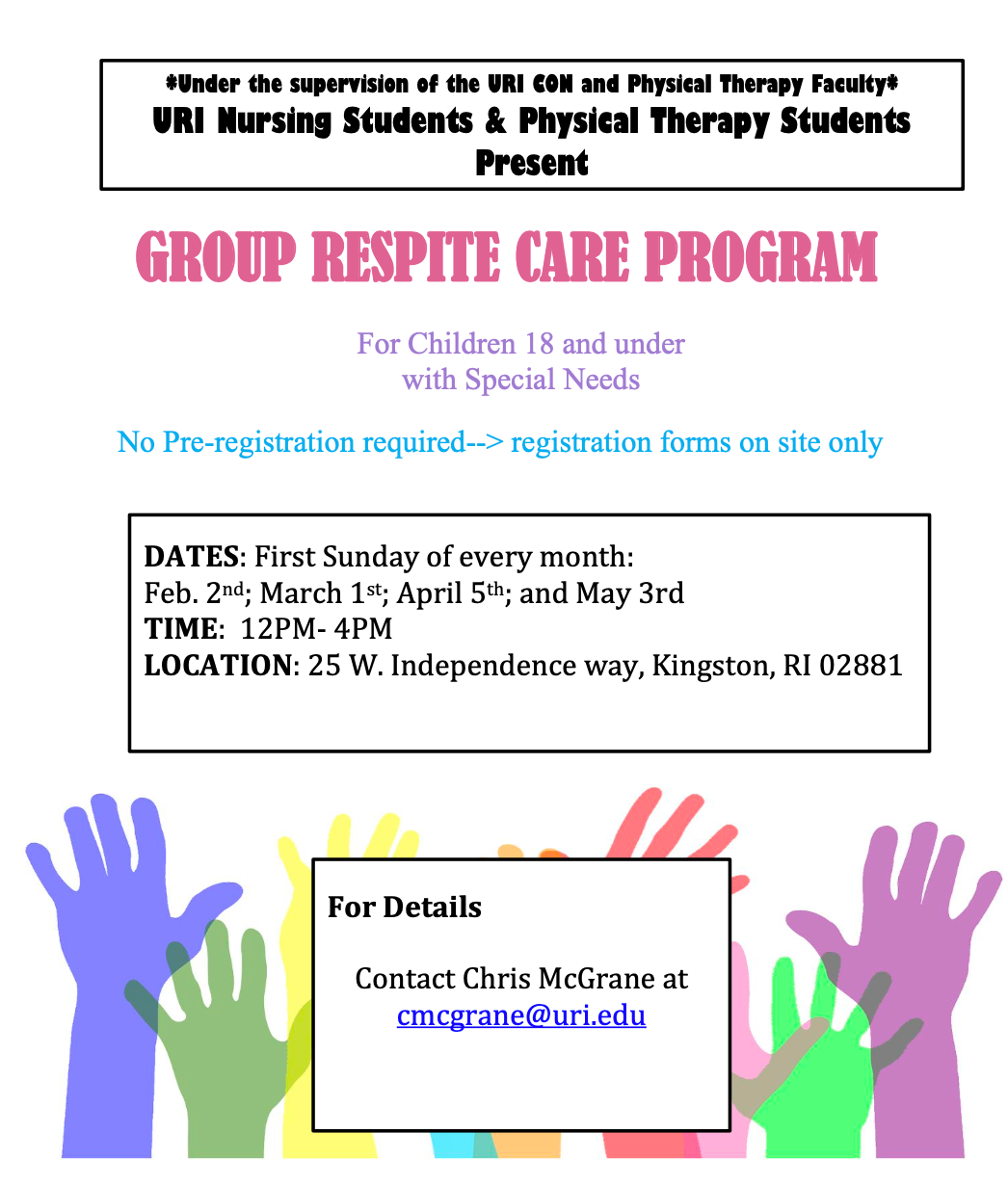Students from URI’s Department of Physical Therapy and College of Nursing coordinate a free monthly respite program for parents of children with special needs. The service is supervised by URI Nursing Clinical Assistant Professor, Christine McGrane, MS, RN, and Physical Therapy Adjunct Professor, Natalie Masson, DPT. The program began as part of McGrane’s doctoral work in September 2018. Hannah Scanlon, a second-year physical therapy student, secured external funding from URI’s Interprofessional Education and Practice Initiative to help fund the program.
Nursing and physical therapy students work together as an interprofessional team to deliver this program. As a result, the students acquire training among the four IPE competencies. Teamwork and collaboration between the two disciplines (roles) is vital to help keep the children entertained and safe, and as a result, the students are consistently bouncing ideas off each other. Students from both professions also enhance their communication skills by using and explaining terminology from their respective fields. This establishes clear communication across disciplines and ensures safety for the program participants. Finally, related to the competency of ethics, students acquire a hands-on understanding of how to maintain child and parent privacy. Scanlon states, “We ask permission to take pictures and make sure all medical information is kept in a secure location.”
The program meets the first Sunday of the month in Independence Square in the Physical Therapy Department for four hours. Parents have an opportunity to drop off their child, where children get individualized supervised care with Nursing and Physical Therapy students. On average, 4-8 children, ranging from 5 to 18 years of age, attend each session. Children that participate in the program have been those living with Cerebral Palsy, Autism or Asperger’s Syndrome. The students from the two disciplines work together to provide developmentally appropriate activities, including games geared toward individualized goals, such as balance, coordination and critical thinking.
With funding from the IPEPI project, the respite program was able to purchase supplies to enrich activities, such as an indoor platform swing, a body sock, sensory toys and a large play tunnel. The body sock looks like a tight-fitting sleeping bag but made of thinner material. Scanlon states, “It helps the kids feel cozy and like they are in a cocoon, which is calming.” The types of activities at each session vary depending on the group of children that attend each month. For instance, if it is a younger group of children, the students will do slower-paced activities, such as stretching and range of motion exercises, using the gait trainer (a mobility aid to assist a patient in walking safely), some nap time, and, most important, keeping the students happy and comfortable. Other activities may include kick ball, going for walks, or visiting the URI hockey rink. Scanlon reports sometimes games are made up spontaneously to meet the needs of the group that day. This has been the biggest challenge students learn to overcome, as the program agenda must adapt depending on the number of children that show up that day. As a result it is hard to have a structured plan. However, having more ideas prepared in advance can help overcome this barrier.
The nursing and PT students exemplify the core of interprofessional education: learning with, from, and about each other. Scanlon states, “many of the children with Cerebral Palsy wear an ankle-foot orthosis (AFO) and we teach the nursing students why AFO’s are important to put on when using the gait trainer.” Likewise, physical therapy students acquire an understanding of tube feedings, as nursing students assist children during snack and meals who need to obtain food through a feeding tube. Feeding varies based on each individual child’s feeding schedule. Scanlon went on to say, “I like working with a large group of nursing students rather than just one – I think it is interesting to see the different experiences each [nursing student] has had.”
When asked what the most valuable part of the experience was for her, Scanlon stated:
“I found having the opportunity to work hands-on with kids that have disability was really beneficial in understanding how much work it is and what their families go through.”
The program allows Scanlon not only to better apply what she learned in class into practice as a future physical therapist, but also better understand the nursing curriculum and career trajectory options for nurses.
The program not only prepares nursing and physical therapy students to work with children, but also to engage and interact with parents and caregivers. Students interact with parents and caregivers at pick up and drop off. Scanlon states, “We encourage students to talk to them about the child such as asking what [their child] likes and doesn’t like, how often they need to be fed or change, or if there is anything else we need to know that was not included on their sign up forms.” Students also update parents and caregivers at the end of each session on how their child did and what activities they participated in that day.
When asked about expanding the program to include other disciplines, Scanlon states,
“ More variety of majors means more resources and information will be shared with parents as well as students. Getting the school of education involved would be beneficial to know how to incorporate things children might be learning in school and how to handle behavioral situations.”
The respite program is a wonderful opportunity for students to acquire hands-on experience with working with children and learning in an interprofessional team. The respite program hopes to expand through increasing the number of children who participate in the program. For more information or to refer a family please contact Christine McGrane, MS, RN. Families do not need to pre-register and registration forms are on site only.

